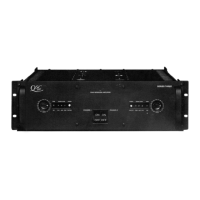19
3. Amplifier Feedback Network, Gain Stage, Distortion LED and Short Circuit Protection
The actual power amplifier begins at the input to the second stage of the op-amp. Audio feedback is established
across R7 and R8. A 47µF non-polar capacitor, E4, in series with R8 ensures that 100% of the DC feedback goes
to the op-amp. This has the effect of rolling off low frequency response below 20Hz, and ensures only a few
millivolts of DC offset at the amplifier output. The added feedback elements R9 and C4 reduce feedback slightly
below about 50 Hz, which counteracts the roll off of E4 in the region of 20-30Hz. Thus, we keep audio response
very flat without unnecessary sub-audio bandwidth, which could lead to unwanted speaker excursions due to breath
pops, etc. The resultant low-frequency response is down .2dB at 20Hz, and 3dB at 8 Hz.
High frequency stability is established by C3 and C2. C3 is the primary “phase lab” capacitor, which sets slew rate
and thus the overall “speed limit” of the circuit. C2 establishes “phase lead” in the speaker feedback network,
increases feedback at very high frequencies and thus improves control at frequencies where oscillations might
occur. C9 and C10, around the emitter resistors of the driver transistors, add a little more phase lead margin. A
speaker output filter, L2, R49, R50, and C5 isolates the amplifier from reactive loads at very high frequencies where
instability might occur.
Most of the gain in the amplifier is contributed by the second stage of the op-amp. This stage’s primary job is to feed
the driver transistors, but is also used to drive the distortion LED (LD1) and is tied in to the short circuit protection
scheme.
As long as the output of the amp is not clipping, the drive voltage to the bases of the driver transistors, Q1 and Q2,
remains below 1.5 volts peak. If the amp clips, the op-amp will attempt to overcome this by instantly delivering a
higher than normal voltage to the drivers. This excess voltage is used to drive the distortion LED (LD2) through
small bridge rectifier, B1, which requires a voltage in excess of about 2.6 volts to operate. Thus any form of clipping
immediately results in illumination of the distortion LED.
One of the featured advantages of the QSC circuit is our effective short circuit protection. In order to maintain good
audio performance into low impedance loads, it is necessary to maintain a high output current limit. The normal
current limit is determined by the base current to each driver through 1K resistors and 3.9V zener diodes (R19 and
R22, Z15 and Z16). When the op-amp rails are at their normal 15V, this current is about 9ma, and results in about a
25A current from the output transistors. This is sufficient to deliver 625 watts RMS to a two-ohm load. The output
transistors can withstand this much current into a short for a few seconds, but would overheat and fail before
thermal shutdown can occur. Therefore, we need a method of reducing current into shorts without affecting normal
operation.
The normal range of currents from the op-amp is less than the current supplied from the main power supply rails by
R33 and R34. However, as full power is reached, and especially if the amp is clipping and the op-amp has to
deliver extra current to the distortion LED, more current is drawn than these resistors can supply, and the op-amp
rail voltage would normally be drawn down. To prevent this, we have a replenishing circuit, from the speaker output
voltage, through R52 (three parallel resistors in early versions) and rectifiers D8 and D9. As long as the load
impedance is above two ohms, there will be enough output voltage to recharge the op-amp rails through this
network. If the output is shorted, however, the output voltage will be clamped to a low value, the recharge will not
occur, and the op-amp will deplete its supply rails to about 6 volts. This will cut the current to the drivers drastically
(through R19 and R22), and reduces output current to a safe level which the amp can withstand until thermal
shutdown occurs. The exact current limits are adjusted using 1k trimmers T2 and T3. (Certain second-generation
revisions will be discussed in section 4 below.)
4. Complementary Driver Transistors, Crossover Bias and High/Low Driver Circuit
The basic circuit design for Series Three is the same as Series One. We only need two stages of discrete devices
to amplify output of the op-amp to full rated power. However, with a little added complexity, we can double the
efficiency of the normal Class B output stage.
First let us examine the lower voltage section of the circuit, which can be regarded as a complete amplifier in itself,
operating from half the main rail voltage. Complementary drivers Q1 and Q2 are connected to the op-amp through
bias diodes D5 and D6. The forward voltage drop of the diodes matches the forward base voltage of Q1 and Q2, so
that as the op-amp swings above and below zero, it immediately drives Q1 or Q2. This eliminates any “dead zone”
which would cause crossover distortion. Trimmer T1 in parallel with R14 permits the bias to be fine-tuned. Emitter

